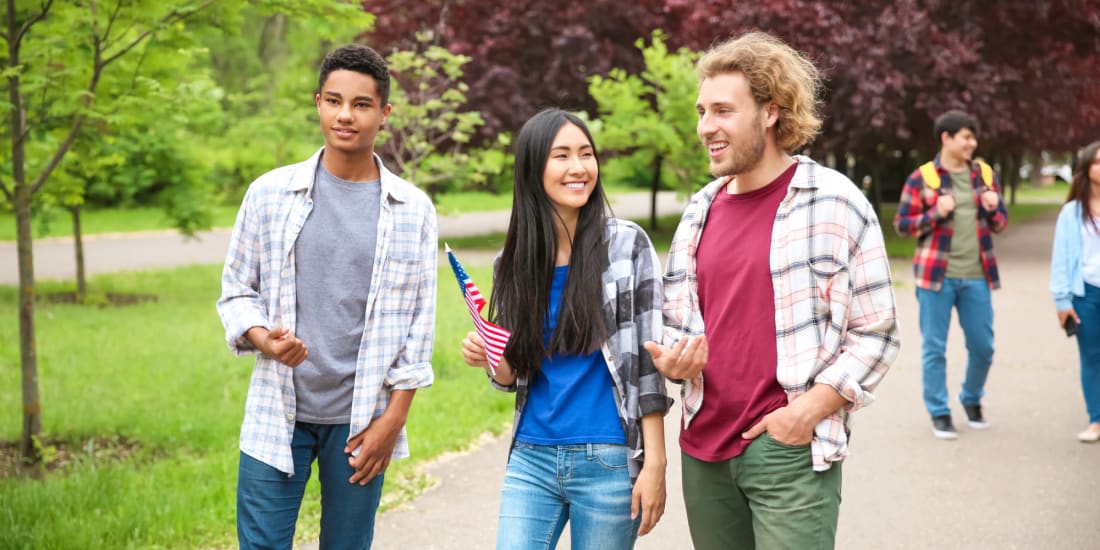Study Master in USA 2024
Study in USA
At 3.79 million square miles (9.83 million km2) in total and with around 315 million people, the United States is the third largest country by land area and population. It is one of the world's most ethnically diverse and multicultural nations, the product of large-scale immigration from many countries.
The geography and climate of the U.S. is also extremely diverse, with deserts, plains, forests, and mountains that are also home to a wide variety of wildlife. The United States of America is located in the Northern hemisphere in North America, just south of Canada and north of the Mexican border. It is composed of 50 states: 48 contiguous states and also Alaska and the Hawaiian Islands.
The USA is known for its many freedoms, including freedom of speech and religion, the right to pursue a lifestyle that is independent of the government or the constraints of the law, as long as one also respects the rights of others. It is founded on the Constitution of America and backed up by the Declaration of Independence signed in 1776, which declared the USA an independent country from Great Britain. The USA is known for a wide variety of higher education, rich culture and arts, and laws that respect the common man. People who come to the USA are expected to respect the laws but will find an open welcome to people of all nationalities and peoples to seek out opportunities in its borders.
Climate
The climate in the USA is very diverse. The Southwest is a hot desert climate, very warm during the summer and no lower than 60° F (16 °C) in the winter. The Pacific Northwest has a temperate oceanic climate, with wet falls and winters but dry and cool springs and summers. The North-Central, Midwestern and New England climate is humid continental.
Here there are four strong seasons with sunny hot summers and snowy winters and the temperature can vary from -20°F ( -29°C) in the winter to 90° F (32°C) in the summer. The Southern Plain and the Atlantic Coast have a temperate humid climate with long hot summers and cool winters. Finally, the Southeast has a warm subtropical climate with temperature from 30 to 50° F (-1 to 10°C) in the winter and from 70 to 90°F (21 to 32°C) in the summer.
Society and Cost of Living
The society of the USA is as diverse as the country itself. There is no caste system though some might argue that point, given the current economy. There are many entrepreneurs and wealthy individuals who have made their own fortune, and there are factory workers making minimum wage.
The cost of living has increased in the USA over recent years, but this varies, according to the state you are in. The cost of living in California is much higher than that of Arkansas, for example. Much of this also depends on the specific area of a state you live in. There are many differences for one state to the other, but all of them have advantages and inconveniences.
The USA is a great country with many freedoms for those who choose to make it their place to study or to live. Studying in the USA offers many exciting opportunities.
Health Insurance
Students may be eligible to join a student health insurance plan or find their own private insurance plan. While health insurance costs are high, there is a wide variety of health plans to choose from with insurance companies. It is important to make sure you are insured before you go, for health costs can become really expensive for an international student if you don't have insurance. Much of this information can be easily found online and free estimates are
available. Sometimes specific schools offer plans you can be on while in school. Check with your school to see if this is offered with your university before attending. It can be part of your tuition fees or you might need to pay extra for it.
Change currency
Basic monthly living cost
Rent in a shared flat
944Share of utilities
65Internet subscription
65Local transportation
64
Sample lifestyle cost
Fast food combo
9Cinema ticket
12Pint of local beer
5
About USA
Higher Education in USA
Higher education is the USA is worldly renowned. Although tuition fees may be expensive, there are many financial aid plans, including loans, grants, and scholarships that are available. People often travel to the USA in search of various higher education options.
Studying in the USA provides a rich cultural and social experience, as well as a full, well-rounded approach to education that you cannot find as easily elsewhere. The USA offers a full higher education menu that prepares students for life after college so they can choose to either stay in the USA or return to their native country after completing.
Some of the most prestigious universities in the USA include Harvard, Yale, and Stanford but there are many other universities within each state which offer a broad curriculum and specified course study in a chosen field. For instance, UCLA in Los Angeles is known for their excellent film program, but Stephen Spielberg and George Lucas attended California State University. It is a very good example of how you
do not have to attend an Ivy League school to get a good education.
The Academic Year
The academic year in USA normally begins in the fall, typically in late August, but some terms may
begin sooner. Some academic years are divided into two semesters, some into four quarters, and some into three quarters. It is important for international students to have everything in place before coming to the USA. Make sure you check with your university the application and the start dates.
Tuition Fees and Length of Study
Tuition fees vary from different universities, so
check with the school you plan to attend for exact costs. The duration of the degree also varies, depending upon which degree you plan to pursue. For example, the CNA license only takes about a year and a half, while Pre-Law takes about three to four years in most cases.
Study Possibilities for International Students
International students can choose from a wide-range of courses and career paths to enhance their learning and provide opportunities to advance their career upon return to their native country. There are also many international student groups available on campus at US schools.
A Higher Education Degree from USA enables students to continue their quest for knowledge beyond their mandatory studies and allows them to seek an advanced career outside the domestic education system and be able to work in research or development.
Student Visas
Student visas are required and these must be up-to-date at the time of arrival. Find out whether you are required to have an F-1 or an M-1 visa - this depends on the specific course of study. The US embassy is the best point of contact to find out this information. There is usually also information on the school website explaining the particulars about visas for that school. You can also contact the admission office or the international students office to obtain more information.
Visa Requirements
1) F visa - This type of visa is for international students who are intending to pursue an academic degree at an accredited US college or university or to study English at a university or intensive English language institute. There are three types of F visa:
- F-1 visas for full-time students;
- F-2 visas for dependents of F-1 visa holders (spouse and unmarried children under the age of 21, including same-sex married couples);
- F-3 visas for ‘border commuters’ – Mexican and Canadian students who reside in their country of origin while attending part- or full-time school in the US.
2) M visa – This type of visa is for international students who want to engage in non-academic or vocational study or training at an institution in the US. There are three types of M visa:
- M-1 visas for students engaging in vocational or non-academic studies;
- M-2 visas for dependents of M-1 visa holders;
- M-3 visas for ‘border commuters’ as in F-3 visas, but for vocational or non-academic studies.
3) J visa – This type of visa is for international exchange visitors participating in programs in the US that promote cultural exchange. All applicants must meet the eligibility criteria of the program in question and be sponsored by a private sector or government program. Holders of J visas usually stay in the US for a short period of time, perhaps one or two semesters. J-1 visa holders will need to return to their home country for at least two years at the end of their exchange visitor program. There are two types of J visa:
- J-1 visas for exchange students on a relevant exchange program;
- J-2 visas for dependents of J-1 visa holders.
What type of Visa do you need?
Visa name
F visa; M visa; J visa
Price and currency
USD 200
You must pay the SEVIS fee (US $200), which supports the cost of the computer system used to record your stay in the US. Go to https://fmjfee.com/index.html to pay the fee and make sure you print a copy of your receipt and bring it to the visa interview. You must pay the SEVIS fee at least three days before the date of your visa interview.
You will also need to pay an additional US$160 for the visa application fee in your country at the U.S. Embassy or Consulate or at a bank that the Embassy designates.
Who can apply for the visa?
All international students coming to study in the US need to apply for an F Visa, J Visa or M Visa.
Where can you make the application?
Online
Each U.S. Embassy has a website providing instructions on how to make an appointment for a visa interview and other information on the visa application process.
Website:http://www.usembassy.gov/
How to make the application?
- First, your school or university will send you a form confirming that you have been accepted at an institution authorized by the U.S. Citizenship and Naturalization Service (USCIS) to enroll non-immigrant students
- Second, you will need to make an appointment for a visa interview and to pay some required fees.
- Third, the United States is using a new non-immigrant visa application form, DS-160 that should be completed online. This form replaces all of the other forms.
- Fourth, prepare for your visa interview. It is crucial that you apply for your visa well in advance, as this will give you extra time if there are delays at the embassy, or if you wish to appeal a decision in the event of a denial. What you wear is important, and business attire is appropriate.
The documents needed for your visa interview may include:
- Passport valid for at least six months beyond your period of stay in the US. You may also need to bring all your current and old passports.
- Signed SEVIS Form I-20 or DS-2019 (including individual forms for spouse/children)
- Form DS-7002 (for J-1 Trainee and Intern visa applicants only)
- SEVIS fee receipt
- DS-160 application confirmation page with barcode and application ID number
- MRV fee payment confirmation receipt
- Printed copy of visa interview appointment letter
- 1-2 photographs in the format explained in the photograph requirements.
You should also be prepared to provide the following documents:
- Transcripts and diplomas from previous institutions attended
- Scores from standardized tests required by the educational institution such as the TOEFL, LSAT, GRE, GMAT, etc.
- Financial evidence showing you or your sponsor (i.e. parents or a government sponsor) has sufficient funds to cover your tuition, travel, and living expenses during your stay in the US.
You can also bring along a separate written list of all your previous employers and schools you have attended for reference.
When should you apply?
Applying for a US student visa can be a long process, so make sure you start preparing well in advance – at least three to five months before your course is due to start. Student Visas can be issued up to 120 days before the date on your form I-20. Exchange Visitor Visas can be issued anytime before the date on the DS-2019.
Processing time
3 Months
Work opportunities
The F1 and J1 visas allow for the possibility of employment in the US during your stay, while the M1 Visa does not. Students with F-1 visas can work on-campus for 20 hours a week or less. Students wishing to work longer hours and off-campus must gain prior authorization from the US Citizenship and Immigration Services (USCIS). J-2 visa holders may request work authorization from USCIS. F-2 and M-visa holders are not allowed to work and must secure an appropriate work visa if seeking employment.
Hours per week
0
Why do you need this type of visa?
The most common reason for a student or exchange visitor application to be denied is that the person applying for the visa has not proven to the Visa Officer that they will return to their country when they complete their studies in the U.S.A. If you are denied a visa there may be something you can do to reverse the denial, and you may appeal the decision. In most cases, you will need to provide additional documentation that was not presented with the initial application.
Institutions
- Seton Hall University
- Oakland University - School of Business Administration
- Capitol Technology University
- Georgia State University
- University of Houston – Conrad N. Hilton College of Global Hospitality Leadership
- Penn State Great Valley School of Graduate Professional Studies
- Arcadia University
- University of Illinois Urbana-Champaign – The Grainger College of Engineering
- Miami Regional University
- NYU Robert F. Wagner School of Public Service


